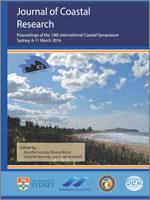Zhang Q.; Gong Z.; Zhang C.K.; Zhou Z., and Townend I., 2016. Hydraulic and sediment dynamics at times of very shallow water on intertidal mudflats: the contribution of waves. In: Vila-Concejo, A.; Bruce, E.; Kennedy, D.M., and McCarroll, R.J. (eds.), Proceedings of the 14th International Coastal Symposium (Sydney, Australia). Journal of Coastal Research, Special Issue, No. 75, pp. 507–511. Coconut Creek (Florida), ISSN 0749-0208.
Intertidal mudflats are often characterized by a special “very shallow water” environment, with a water depth in the order of 10 cm. High-resolution data including water depth, wave parameters, velocity profiles (within 3–6 cm above the mudflat surface with a vertical resolution as fine as 1 mm), stratified suspended sediment concentration (SSC) and bed deformation over the intertidal mudflat during August 8–10, 2013 were measured using a self-designed measuring system. High-resolution stratified velocities near the bottom under different tide and wave conditions were compared to the Karman-Prandtl model. Results suggest that the vertical structure of velocity profiles within 55 cm above the bed maintain a logarithmic distribution even when waves were relatively large. In addition, bed shear stresses under current and wave alone and combined current-wave conditions were calculated to evaluate the contribution of waves. This suggests that waves do not induce a significant rise in the bed shear stress, but have a pronounced impact on the sediment suspension. This is particularly the case for very shallow flows during both the early-flood period and the late-ebb period. These periods were characterized by “surges” in velocity and SSC, which are enhanced when waves become larger. Even small waves cannot be overlooked for their contribution to sediment re-suspension and vertical mixing. We conclude that waves strengthen the response of micro-topography deformation due to flow conditions. They enhance the forcing during the “surges” at times of very shallow water, to sculpt the micro-topography of the bed.





